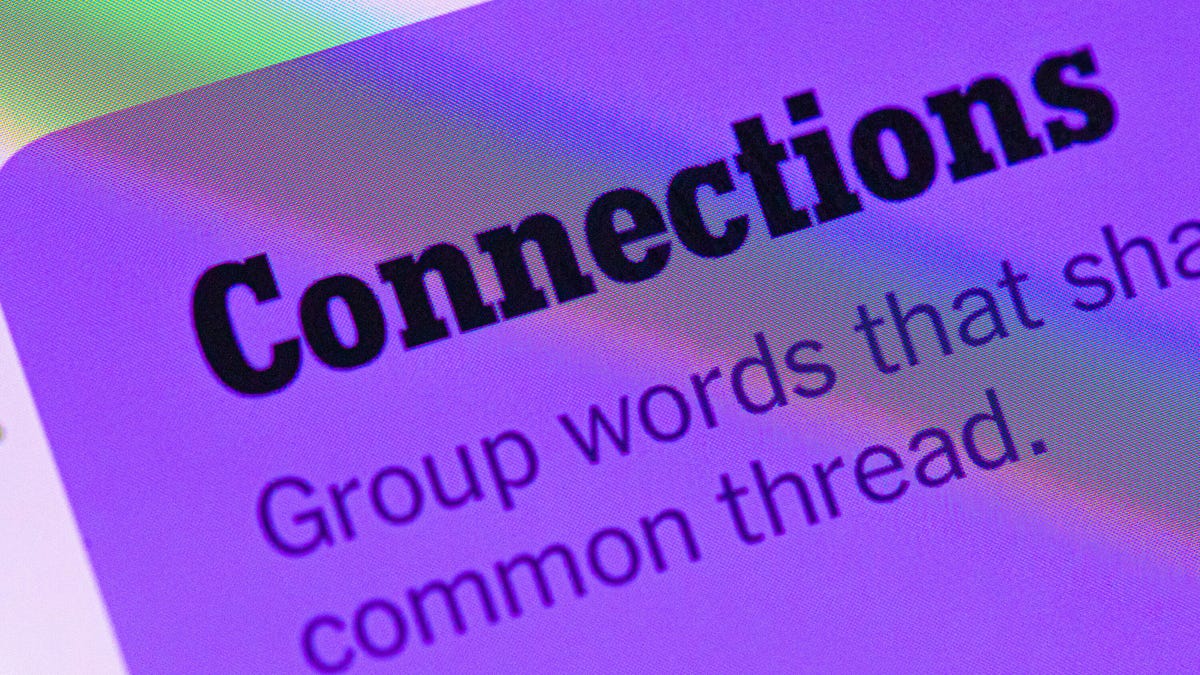Technologies
A Federal Moratorium on State AI Rules Is Inching Closer to Passing. Why It Matters
Congress is considering a policy that would stop states from having their own regulations around artificial intelligence.

States and local governments would be limited in how they can regulate artificial intelligence under a proposal currently before Congress. AI leaders say the move would ensure the US can lead in innovation, but critics say it could lead to fewer consumer protections for the fast-growing technology.
The proposal, as passed by the House of Representatives, says no state or political subdivision «may enforce any law or regulation regulating artificial intelligence models, artificial intelligence systems or automated decision systems» for 10 years. In May, the House added it to the full budget bill, which also includes the extension of the 2017 federal tax cuts and cuts to services like Medicaid and SNAP. The Senate has made some changes, namely that the moratorium would only be required for states that accept funding as part of the $42.5 billion Broadband, Equity, Access, and Deployment program.
AI developers and some lawmakers have said federal action is necessary to keep states from creating a patchwork of different rules and regulations across the US that could slow the technology’s growth. The rapid growth in generative AI since OpenAI’s ChatGPT exploded on the scene in late 2022 has led companies to wedge the technology in as many spaces as possible. The economic implications are significant, as the US and China race to see which country’s tech will predominate, but generative AI poses privacy, transparency and other risks for consumers that lawmakers have sought to temper.
«[Congress has] not done any meaningful protective legislation for consumers in many, many years,» Ben Winters, director of AI and privacy at the Consumer Federation of America, told me. «If the federal government is failing to act and then they say no one else can act, that’s only benefiting the tech companies.»
Efforts to limit the ability of states to regulate artificial intelligence could mean fewer consumer protections around a technology that is increasingly seeping into every aspect of American life. «There have been a lot of discussions at the state level, and I would think that it’s important for us to approach this problem at multiple levels,» said Anjana Susarla, a professor at Michigan State University who studies AI. «We could approach it at the national level. We can approach it at the state level, too. I think we need both.»
Several states have already started regulating AI
The proposed language would bar states from enforcing any regulation, including those already on the books. The exceptions are rules and laws that make things easier for AI development and those that apply the same standards to non-AI models and systems that do similar things. These kinds of regulations are already starting to pop up. The biggest focus is not in the US, but in Europe, where the European Union has already implemented standards for AI. But states are starting to get in on the action.
Colorado passed a set of consumer protections last year, set to go into effect in 2026. California adopted more than a dozen AI-related laws last year. Other states have laws and regulations that often deal with specific issues such as deepfakes or require AI developers to publish information about their training data. At the local level, some regulations also address potential employment discrimination if AI systems are used in hiring.
«States are all over the map when it comes to what they want to regulate in AI,» said Arsen Kourinian, a partner at the law firm Mayer Brown. So far in 2025, state lawmakers have introduced at least 550 proposals around AI, according to the National Conference of State Legislatures. In the House committee hearing last month, Rep. Jay Obernolte, a Republican from California, signaled a desire to get ahead of more state-level regulation. «We have a limited amount of legislative runway to be able to get that problem solved before the states get too far ahead,» he said.
While some states have laws on the books, not all of them have gone into effect or seen any enforcement. That limits the potential short-term impact of a moratorium, said Cobun Zweifel-Keegan, managing director in Washington for the International Association of Privacy Professionals. «There isn’t really any enforcement yet.»
A moratorium would likely deter state legislators and policymakers from developing and proposing new regulations, Zweifel-Keegan said. «The federal government would become the primary and potentially sole regulator around AI systems,» he said.
What a moratorium on state AI regulation means
AI developers have asked for any guardrails placed on their work to be consistent and streamlined.
«We need, as an industry and as a country, one clear federal standard, whatever it may be,» Alexandr Wang, founder and CEO of the data company Scale AI, told lawmakers during an April hearing. «But we need one, we need clarity as to one federal standard and have preemption to prevent this outcome where you have 50 different standards.»
During a Senate Commerce Committee hearing in May, OpenAI CEO Sam Altman told Sen. Ted Cruz, a Republican from Texas, that an EU-style regulatory system «would be disastrous» for the industry. Altman suggested instead that the industry develop its own standards.
Asked by Sen. Brian Schatz, a Democrat from Hawaii, if industry self-regulation is enough at the moment, Altman said he thought some guardrails would be good, but, «It’s easy for it to go too far. As I have learned more about how the world works, I am more afraid that it could go too far and have really bad consequences.» (Disclosure: Ziff Davis, parent company of CNET, in April filed a lawsuit against OpenAI, alleging it infringed Ziff Davis copyrights in training and operating its AI systems.)
Not all AI companies are backing a moratorium, however. In a New York Times op-ed, Anthropic CEO Dario Amodei called it «far too blunt an instrument,» saying the federal government should create transparency standards for AI companies instead. «Having this national transparency standard would help not only the public but also Congress understand how the technology is developing, so that lawmakers can decide whether further government action is needed.»
Concerns from companies, both the developers that create AI systems and the «deployers» who use them in interactions with consumers, often stem from fears that states will mandate significant work such as impact assessments or transparency notices before a product is released, Kourinian said. Consumer advocates have said more regulations are needed, and hampering the ability of states could hurt the privacy and safety of users.
A moratorium on specific state rules and laws could result in more consumer protection issues being dealt with in court or by state attorneys general, Kourinian said. Existing laws around unfair and deceptive practices that are not specific to AI would still apply. «Time will tell how judges will interpret those issues,» he said.
Susarla said the pervasiveness of AI across industries means states might be able to regulate issues such as privacy and transparency more broadly, without focusing on the technology. But a moratorium on AI regulation could lead to such policies being tied up in lawsuits. «It has to be some kind of balance between ‘we don’t want to stop innovation,’ but on the other hand, we also need to recognize that there can be real consequences,» she said.
Much policy around the governance of AI systems does happen because of those so-called technology-agnostic rules and laws, Zweifel-Keegan said. «It’s worth also remembering that there are a lot of existing laws and there is a potential to make new laws that don’t trigger the moratorium but do apply to AI systems as long as they apply to other systems,» he said.
Will an AI moratorium pass?
With the bill now in the hands of the US Senate — and with more people becoming aware of the proposal — debate over the moratorium has picked up. The proposal did clear a significant procedural hurdle, with the Senate parliamentarian ruling that it does pass the so-called Byrd rule, which states that proposals included in a budget reconciliation package have to actually deal with the federal budget. The move to tie the moratorium to states accepting BEAD funding likely helped, Winters told me.
Whether it passes in its current form is now less a procedural question than a political one, Winters said. Senators of both parties, including Republican Sens. Josh Hawley and Marsha Blackburn, have voiced their concerns about tying the hands of states.
«I do think there’s a strong open question about whether it would be passed as currently written, even though it wasn’t procedurally taken away,» Winters said.
Whatever bill the Senate approves will then also have to be accepted by the House, where it passed by the narrowest of margins. Even some House members who voted for the bill have said they don’t like the moratorium, namely Rep. Marjorie Taylor Greene, a key ally of President Donald Trump. The Georgia Republican posted on X this week that she is «adamantly OPPOSED» to the moratorium and that she would not vote for the bill with the moratorium included.
At the state level, a letter signed by 40 state attorneys general — of both parties — called for Congress to reject the moratorium and instead create that broader regulatory system. «This bill does not propose any regulatory scheme to replace or supplement the laws enacted or currently under consideration by the states, leaving Americans entirely unprotected from the potential harms of AI,» they wrote.
Technologies
Today’s NYT Mini Crossword Answers for Friday, Dec. 26
Here are the answers for The New York Times Mini Crossword for Dec. 26.

Looking for the most recent Mini Crossword answer? Click here for today’s Mini Crossword hints, as well as our daily answers and hints for The New York Times Wordle, Strands, Connections and Connections: Sports Edition puzzles.
Need some help with today’s Mini Crossword? Some of the clues are tough today — I thought maybe 1-Across was referring to the Grinch, or even Oscar the Grouch, but was I ever wrong! Read on for all the answers. And if you could use some hints and guidance for daily solving, check out our Mini Crossword tips.
If you’re looking for today’s Wordle, Connections, Connections: Sports Edition and Strands answers, you can visit CNET’s NYT puzzle hints page.
Read more: Tips and Tricks for Solving The New York Times Mini Crossword
Let’s get to those Mini Crossword clues and answers.
Mini across clues and answers
1A clue: Furry and green, say
Answer: MOSSY
6A clue: State known for its potatoes
Answer: IDAHO
7A clue: Like a faithful friend
Answer: LOYAL
8A clue: Had a beverage
Answer: DRANK
9A clue: Pronoun frequently paired with «her»
Answer: SHE
Mini down clues and answers
1D clue: Not spicy, as salsa
Answer: MILD
2D clue: Reasons for wrinkled noses
Answer: ODORS
3D clue: Words from a doctor checking your tonsils
Answer: SAYAH
4D clue: Comedian Gillis
Answer: SHANE
5D clue: Part of an egg used to make hollandaise sauce
Answer: YOLK
Don’t miss any of our unbiased tech content and lab-based reviews. Add CNET as a preferred Google source.
Technologies
Today’s NYT Connections: Sports Edition Hints and Answers for Dec. 26, #459
Here are hints and the answers for the NYT Connections: Sports Edition puzzle for Dec. 26, No. 459.

Looking for the most recent regular Connections answers? Click here for today’s Connections hints, as well as our daily answers and hints for The New York Times Mini Crossword, Wordle and Strands puzzles.
Today’s Connections: Sports Edition is a tough one. That purple category once again has players looking for a different, but related, hidden word in four of the clues. If you’re struggling with today’s puzzle but still want to solve it, read on for hints and the answers.
Connections: Sports Edition is published by The Athletic, the subscription-based sports journalism site owned by The Times. It doesn’t appear in the NYT Games app, but it does in The Athletic’s own app. Or you can play it for free online.
Read more: NYT Connections: Sports Edition Puzzle Comes Out of Beta
Hints for today’s Connections: Sports Edition groups
Here are four hints for the groupings in today’s Connections: Sports Edition puzzle, ranked from the easiest yellow group to the tough (and sometimes bizarre) purple group.
Yellow group hint: Big Apple jock.
Green group hint: College football fun.
Blue group hint: On the road.
Purple group hint: Hunt down a word in other words.
Answers for today’s Connections: Sports Edition groups
Yellow group: A New York athlete.
Green group: Bowl games.
Blue group: Associated with a team road trip.
Purple group: Ends in a movement verb.
Read more: Wordle Cheat Sheet: Here Are the Most Popular Letters Used in English Words
What are today’s Connections: Sports Edition answers?
The yellow words in today’s Connections
The theme is a New York athlete. The four answers are Islander, Net, Ranger and Yankee.
The green words in today’s Connections
The theme is bowl games. The four answers are Alamo, Gator, Liberty and Pinstripe.
The blue words in today’s Connections
The theme is associated with a team road trip. The four answers are bus, flight, hotel and visiting locker room.
The purple words in today’s Connections
The theme is ends in a movement verb. The four answers are foxtrot (trot), newsprint (sprint), terrace (race) and thunderbolt (bolt).
Don’t miss any of our unbiased tech content and lab-based reviews. Add CNET as a preferred Google source.
Technologies
Today’s NYT Connections Hints, Answers and Help for Dec. 26, #929
Here are some hints and the answers for the NYT Connections puzzle for Dec. 26 #929

Looking for the most recent Connections answers? Click here for today’s Connections hints, as well as our daily answers and hints for The New York Times Mini Crossword, Wordle, Connections: Sports Edition and Strands puzzles.
Today’s NYT Connections puzzle is full of fun pop-culture references. Read on for clues and today’s Connections answers.
The Times has a Connections Bot, like the one for Wordle. Go there after you play to receive a numeric score and to have the program analyze your answers. Players who are registered with the Times Games section can now nerd out by following their progress, including the number of puzzles completed, win rate, number of times they nabbed a perfect score and their win streak.
Read more: Hints, Tips and Strategies to Help You Win at NYT Connections Every Time
Hints for today’s Connections groups
Here are four hints for the groupings in today’s Connections puzzle, ranked from the easiest yellow group to the tough (and sometimes bizarre) purple group.
Yellow group hint: Golden state cliches.
Green group hint: Funny films.
Blue group hint: Rock on.
Purple group hint: Not white.
Answers for today’s Connections groups
Yellow group: California-based character tropes.
Green group: Comedy subgenres.
Blue group: ’70s rock bands.
Purple group: Black ____.
Read more: Wordle Cheat Sheet: Here Are the Most Popular Letters Used in English Words
What are today’s Connections answers?
The yellow words in today’s Connections
The theme is California-based character tropes. The four answers are movie exec, surfer, tech bro and Valley Girl.
The green words in today’s Connections
The theme is comedy subgenres. The four answers are buddy, cringe, screwball and stoner.
The blue words in today’s Connections
The theme is ’70s rock bands. The four answers are America, Chicago, Foreigner and Journey.
The purple words in today’s Connections
The theme is black ____. The four answers are Forest, Friday, Panther and Widow.
Don’t miss any of our unbiased tech content and lab-based reviews. Add CNET as a preferred Google source.
-

 Technologies3 года ago
Technologies3 года agoTech Companies Need to Be Held Accountable for Security, Experts Say
-

 Technologies3 года ago
Technologies3 года agoBest Handheld Game Console in 2023
-

 Technologies3 года ago
Technologies3 года agoTighten Up Your VR Game With the Best Head Straps for Quest 2
-

 Technologies4 года ago
Technologies4 года agoBlack Friday 2021: The best deals on TVs, headphones, kitchenware, and more
-

 Technologies4 года ago
Technologies4 года agoVerum, Wickr and Threema: next generation secured messengers
-

 Technologies4 года ago
Technologies4 года agoGoogle to require vaccinations as Silicon Valley rethinks return-to-office policies
-

 Technologies4 года ago
Technologies4 года agoOlivia Harlan Dekker for Verum Messenger
-

 Technologies4 года ago
Technologies4 года agoiPhone 13 event: How to watch Apple’s big announcement tomorrow
